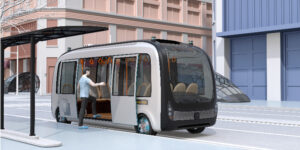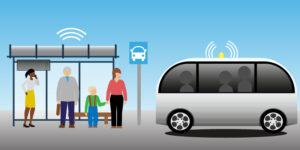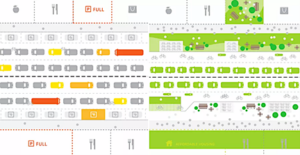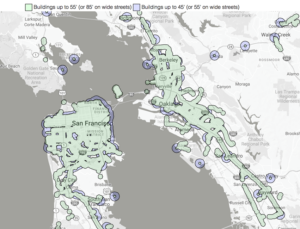A bumpy ride: How autonomous transportation may change land use planning policy

This piece is part of StrategyCorp’s Groundswell series on grassroots advocacy.
Autonomous vehicles (AV) are already remaking the transportation landscape in North America. At this point, few would be surprised to hear it. Deployment of AV technology has rapidly moved from theoretical to reality.
We’ve already seen self-driving Volvos and freight trucks in Arizona, test AVs from GM’s Cruise Automation roaming the streets in San Francisco and Uber’s self-driving fleet in Pittsburgh. Much digital ink has been spilled on Detroit’s resurgence and reimagining Motor City as a driverless hub for the balance of this century.
North of the border, Canada is also embracing and preparing for an AV future. In Ontario—home to the largest automotive manufacturing footprint in Canada—the Autonomous Vehicle Innovation Network, a provincially-funded organization that promotes local development of AV technology, has set up a Demonstration Zone. Located in Stratford, Ontario, it’s a controlled environment where AV testing can occur and Ontario innovators can demonstrate their technology to major motor vehicle companies, in part by utilizing 12 square kilometers of ubiquitous city Wi-Fi.
 But transportation is a lot more than just how we get around. It’s also about how we live, where we cluster, co-locate, and congregate. Transportation defines where we work, or shop, and how we socialize. And while it’s still early, AV has the potential to reshape land use policy—that never-ending process of deciding what goes where—in urban hubs across the country.
But transportation is a lot more than just how we get around. It’s also about how we live, where we cluster, co-locate, and congregate. Transportation defines where we work, or shop, and how we socialize. And while it’s still early, AV has the potential to reshape land use policy—that never-ending process of deciding what goes where—in urban hubs across the country.
Several North American cities are already planning.
“We’re already starting to tweak a little bit our land-use pattern and our regulation,” Terry Croad, Director of Planning for the City of Southfield, Mich., told Driven.
The AV Working Group for planners in Michigan believes that the hallmarks of today’s cityscape—think wide travel lanes and large parking lots—will be “rendered unnecessary where people use connected, driverless cars, or [AVs on] ride-sharing platforms.”
The Future Is Getting Nearer
 Beyond the Demonstration Zone and on real city streets, the pace is accelerating. In January 2019, the Government of Ontario changed regulations to allow for the public purchase of SAE Level 3 vehicles. Ontario also launched the AV Pilot Program, which allows AVs to be tested on public roads, so long as human oversight is maintained. This could mean a person in a vehicle or remote monitoring of an AV, provided a person can intervene if needed.
Beyond the Demonstration Zone and on real city streets, the pace is accelerating. In January 2019, the Government of Ontario changed regulations to allow for the public purchase of SAE Level 3 vehicles. Ontario also launched the AV Pilot Program, which allows AVs to be tested on public roads, so long as human oversight is maintained. This could mean a person in a vehicle or remote monitoring of an AV, provided a person can intervene if needed.
Cities aren’t waiting for private ownership to thrust AVs forward. Toronto and its provincial transit authority Metrolinx have committed to testing a Local Motors Olli 2.0 AV as a micro-transit shuttle in the city’s east end. It’s a novel last-mile solution: an 8-seat driverless shuttle, serving a local neighbourhood with no transit access and linking it with the regional commuter rail (GO) station. The pilot is currently scheduled to begin in fall 2021, but it showcases a salient and microcosmic proof-of-concept: a shared AV pool resulting in a net decrease of up to seven passenger vehicles.
What does it all mean, both for Canadians and for residents in advanced cities across the globe?
According to estimates cited in a 2017 report prepared by the Information and Communications Technology Council (ICTC) and commissioned by the Government of Canada, the “full-scale” use of AVs will precipitate a 60 percent drop in vehicles on city streets. The same ICTC report points to a study that estimates a savings of 5.7 billion square meters of parking space just in the in the United States by 2035.
Which leads to an even bigger question: how will reclaiming urban space reorganize how we live in cities? Are we ready for that disruption?
Land Use Policy Impacts
 San Francisco is often considered the perfect place to start rethinking what land use looks like in our autonomous future. As a city with limited land area that’s accustomed to technological innovation—but beset by a chronic affordability crisis—it could be ground zero for how AV can reshape land use for the next generation.
San Francisco is often considered the perfect place to start rethinking what land use looks like in our autonomous future. As a city with limited land area that’s accustomed to technological innovation—but beset by a chronic affordability crisis—it could be ground zero for how AV can reshape land use for the next generation.
Like cities across the United States and Canada, San Francisco launched a Transportation Demand Management (TDM) program about five years ago. It’s an initiative of the City’s transit authority (SFMTA) and the Planning Department. Designed to spur development that prioritizes modes of transportation other than the single-occupancy car, it encourages a variety of land use policy changes, primarily around parking minimums and vehicle usage.
Developers in San Francisco are encouraged to build less parking and are given the opportunity to intentionally “underpark” developments through a simple approval process. In the absence of parking, in addition to transit, shared AVs are typically suggested as a better medium- or long-range alternative. (In Ontario, the province’s transit-oriented communities [TOC] program has brought a similar emphasis, especially in and around Toronto.)
Further, best practices studies like the Blueprint for Autonomous Urbanism from National Association of City Transportation Officials (NACTO) recommend a variety of land use changes relating to transit-oriented development. That means not only eliminating or significantly reducing parking requirements, but also ramping up density and allowing increased building heights.
These ideas include dramatic changes to zoning codes and will require vigorous discussion with neighbours and communities.
Land use changes are always possible, but they must come from the ground up.
Addressing Affordable Housing
As part of the 2016 Smart City Challenge, SFMTA submitted a vision of what an autonomous future might look like for land use and transportation. Grant funding from the United States Department of Transportation of about $40 million was at stake.
The most significant land use policy element of San Francisco’s Smart City vision was the theory that AVs could help solve the city’s most immediate challenge: affordable housing.

The image on the left shows current conditions: a roadway with parked cars and a neighbourhood dedicating space to personal vehicle parking. On the right is a SFTMA “Smart City” concept that replaces much of the traffic with AV and frees parking for affordable, transit-oriented housing. (Image credit: SFMTA)
The Smart City vision believes that by removing and reducing land used for personal vehicle parking and replacing it with a blend of transit and electric shared autonomous vehicles (SAV), new affordable housing can be built. One academic study published in 2015 estimated that parking needs would be reduced up to 90 percent in an urban SAV environment. Other scholarly estimates believe the reductions in commercial zones will be closer to 40 percent.
Additionally, lanes could be narrowed and rights-of-way could be constructed differently to accommodate AVs, transit, pedestrians, and cyclists, creating an affordable form of urbanism that aligns with the Smart City goals and creates a pilot project for what SAV-oriented land use might look like.
On a much larger scale there was SB 827, a bill authored by State Sen. Scott Wiener which was under consideration in 2018 at the State Senate in Sacramento. It would have enacted some radical changes to encourage transit-oriented development. In essence, Sen. Wiener’s bill would have preempted local zoning rules regarding height, density, and minimum parking requirements within a quarter or half-mile of a transit connection. According to maps on TransitRichHousing.org, SB 827 would have therefore overridden local zoning rules in nearly every square inch of San Francisco. (Despite support from many forward-thinking planning advocates, it ultimately failed to pass.)
Imagine the results: dense high-rises with limited parking and therefore, little need for personal vehicles. Into that void will be a mix of public transit, ride-hailing companies and shared AV.

Effects of SB 827 on building height controls (Map credit: TransitRichHousing.org)
Here in Ontario, we already see government catching up: in 2019, the premier’s cabinet dedicated an Assistant Minister to oversee a provincial Transit-Oriented Communities program.
Regardless of jurisdiction, the hard work will be done at the municipal level. So how can our cities accommodate this shift?
Create a Smoother Ride
Changes—big or small—that include a reliance on transit and AV would create tremendous upheaval in the affected areas, particularly urban areas. Backers of these transformed-by-AV land use policies are going to need help building bridges with neighbours, transit riders, businesses, civic associations and property owners. Cities and even autonomous vehicle companies themselves would be facing a daunting public affairs challenge that can only be solved by genuine grassroots engagement.
In other words, all stakeholders need to be engaged. As a trio of land use professionals write at Planetizen:
In looking at the group conversations on the potential outcomes of an autonomous future, we believe that the focus needs to stay on the goals of the community. The deployment of these technologies needs to improve quality of life, ensure social equity, take care of all residents’ needs, and create opportunities for commerce.
Planners, administrators, and elected officials cannot simply think about how to accommodate these technologies, as has been the case in many of the conversations about AV policy around the country. As innovation develops, individuals must plan for the communities (and places) that the public wants to see and leverage the technology to help attain those goals.
Listening, educating and advocating for these future-looking changes would be just the beginning. To capitalize on emerging AV technology for greener, more livable, and more affordable cities, advocates can’t simply rely on a top-down approach that espouses theories of urbanism and cites academic studies. The only way to pave this future—with the least upheaval—is a robust, bottom-up, grassroots approach, which we discussed in-detail recently.